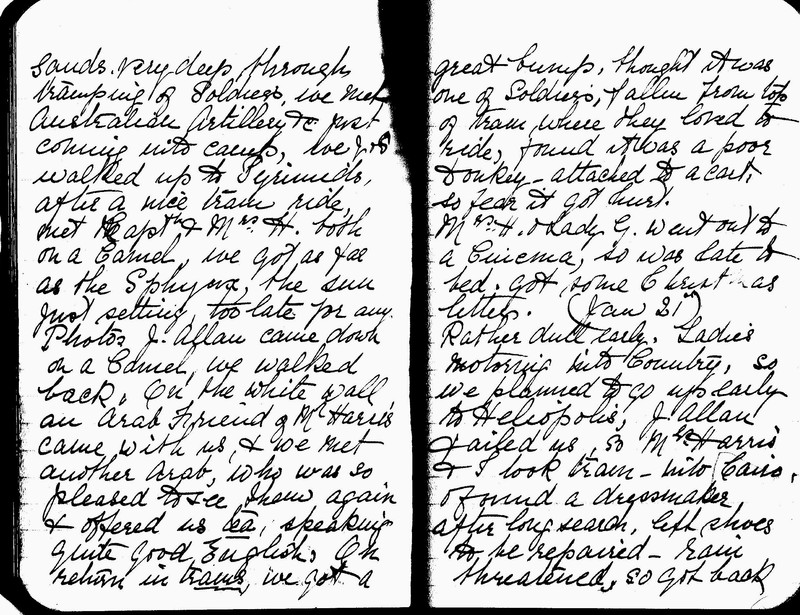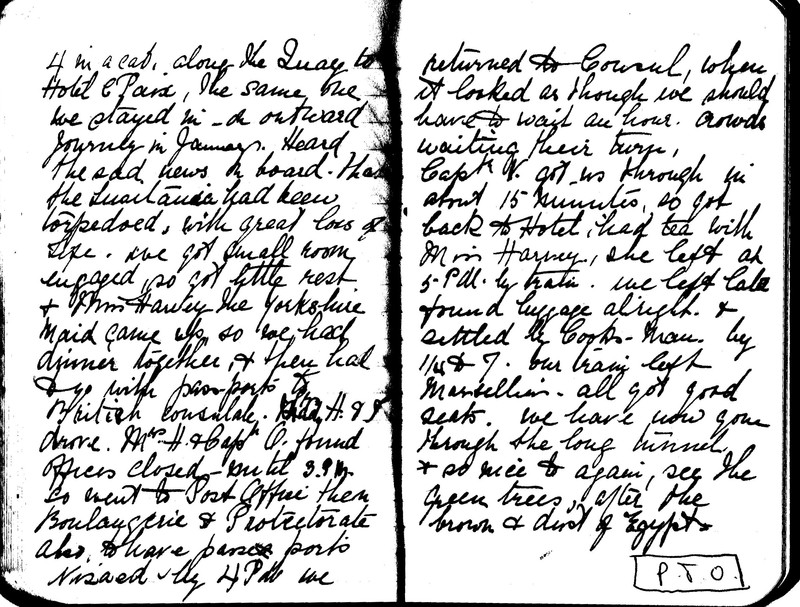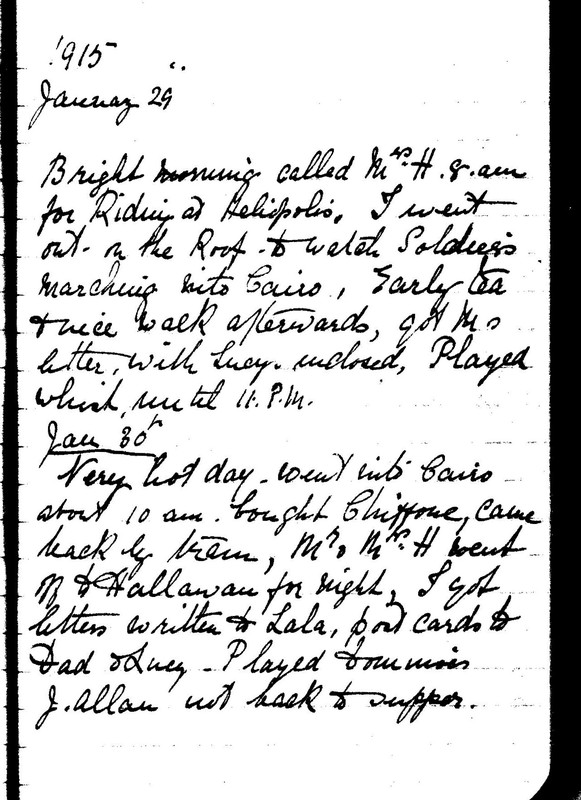Lily Jane Hawkins (diary)
Item
Title
Lily Jane Hawkins (diary)
Who?
Lily Jane Hawkins
Item(s)
Diary that includes description of Lily Hawkins’s travels as a lady’s maid to Lady Mary Herbert in the eastern Mediterranean, including Cairo, during the Gallipoli campaign, 1915. This is a substantial diary, and extracts relevant to the wartime events have been photocopied.
Story
Lily Jane Hawkins was older sister to William and Fred. She was born August 3rd 1871, the fifth of ten children, and died at the age of 94, August 1965. She was in service all her working life, as Lady’s Maid to Lady Mary Herbert (1889-1970), wife of Colonel the Honourable Aubrey Herbert (1880-1923). Aubrey Herbert was educated at Eton and Balliol, took a first in modern history, and was noted for climbing on the college roofs despite his near blindness. He was a favourite half-brother of the 5th Earl of Carnarvon, noted Egyptologist who sponsored Howard Carter’s excavations of the Tomb of Tutankhamun. Mary Herbert was born Mary Vesey, daughter of the 4th Viscount of De Vesci, of Abbeyleix, Ireland.
During 1915 Lily Jane Hawkins travelled with the family to Cairo. Lady Mary went shopping; Captain Herbert was on active service at Gallipoli. Aubrey Herbert was a Conservative MP from 1911 until his death. He was a polyglot who spoke several European languages but also Turkish and Arabic. In 1914 he joined the Irish Guards and took part in the Battle of Mons, where he was wounded, taken POW and escaped. From January 1915 he was attached to the Intelligence Department in Cairo, Egypt. In the Gallipoli campaign Herbert worked as liaison officer and interpreter to the ANZAC General’s Staff. He was with the troops that landed at Gaba Tepe, later known as Anzac Cove, on Sunday 25 April 1915. This amphibious invasion of the Gallipoli Peninsula by the forces of the British Empire began the land phase of the Gallipoli Campaign. Captain Aubrey Herbert recorded, and commented on, the events of that night :
____
Sunday 25 April
We landed on a spit of land which in those days we called Shrapnel Point, to the left of what afterwards became Corps Headquarters, though later the other spit on the right usurped that name. I took cover under a bush with a New Zealand officer, Major Browne.
There were lines of men clinging like cockroaches under the cliffs or moving silently as the guns on the right and left enfiladed us. The only thing to be done was to dig in as soon as possible, but a good many men were shot while they were doing this. We remained on the beach - - - We had no artillery to keep the enemy’s fire down.
We spent a chilly night, sometimes lying down, sometimes walking, as the rain began to fall after dark, and we had not too much food.
We were very hard pressed; as every draft landed it was hurried off to that spot in the line where reinforcements were most needed. This naturally produced chaos amongst the units, and order was not re-established for some time. It was a terrible night for those in authority. I believe that had it been possible, we should have re-embarked that night, but the sacrifices involved would have been too great. Preparations for the expedition had been totally inadequate. The chief RAMC officer had told me the ridiculously small number of casualties he had been ordered to make preparations for, and asked my opinion, which I gave him with some freedom. As it was, we had to put six hundred men on the ship from which we had disembarked in the morning, to go back to hospital in Egypt, a four days’ journey, under the charge of one officer – who was a veterinary surgeon!
Monday, 26 April
We slept on a ledge a few feet above the beach. Firing went on all night. In the morning it was very cold, and we were all soaked. The Navy, it appeared, had landed us in the wrong place. This made the Army extremely angry, though as things turned out it was the one bright spot. Had we landed anywhere else, we should have been wiped out.
____
The exact number of casualties is not known, but the ANZACS had landed two divisions and at least 2,000 of their men had been killed or wounded. Since 1916 the anniversary of the landings on 25 April has been commemorated as Anzac Day in Australia and New Zealand.
As a Turkish speaker, Captain Herbert had useful pre-war contacts that enabled him to arrange a truce with Mustafa Kemal on Whit Monday, May 24, for the purpose of burying the dead. This episode appears in Louise de Bernière’s novel, Birds without Wings, where he is presented as ‘the honourable Herbert’.
The Herbert family lived at Pixton Park, Dulverton, Somerset. Laura, the daughter of Mary and Aubrey Herbert, was born there in June 1916 and married the novelist, Evelyn Waugh, in 1937.
Lily Hawkins had a sister, Margaret, who was also a Lady’s Maid, and travelled extensively in Europe and to Russia before World War I. In later life, the two sisters, Lily and Margaret, lived together. Margaret died in 1960, aged 90.
During 1915 Lily Jane Hawkins travelled with the family to Cairo. Lady Mary went shopping; Captain Herbert was on active service at Gallipoli. Aubrey Herbert was a Conservative MP from 1911 until his death. He was a polyglot who spoke several European languages but also Turkish and Arabic. In 1914 he joined the Irish Guards and took part in the Battle of Mons, where he was wounded, taken POW and escaped. From January 1915 he was attached to the Intelligence Department in Cairo, Egypt. In the Gallipoli campaign Herbert worked as liaison officer and interpreter to the ANZAC General’s Staff. He was with the troops that landed at Gaba Tepe, later known as Anzac Cove, on Sunday 25 April 1915. This amphibious invasion of the Gallipoli Peninsula by the forces of the British Empire began the land phase of the Gallipoli Campaign. Captain Aubrey Herbert recorded, and commented on, the events of that night :
____
Sunday 25 April
We landed on a spit of land which in those days we called Shrapnel Point, to the left of what afterwards became Corps Headquarters, though later the other spit on the right usurped that name. I took cover under a bush with a New Zealand officer, Major Browne.
There were lines of men clinging like cockroaches under the cliffs or moving silently as the guns on the right and left enfiladed us. The only thing to be done was to dig in as soon as possible, but a good many men were shot while they were doing this. We remained on the beach - - - We had no artillery to keep the enemy’s fire down.
We spent a chilly night, sometimes lying down, sometimes walking, as the rain began to fall after dark, and we had not too much food.
We were very hard pressed; as every draft landed it was hurried off to that spot in the line where reinforcements were most needed. This naturally produced chaos amongst the units, and order was not re-established for some time. It was a terrible night for those in authority. I believe that had it been possible, we should have re-embarked that night, but the sacrifices involved would have been too great. Preparations for the expedition had been totally inadequate. The chief RAMC officer had told me the ridiculously small number of casualties he had been ordered to make preparations for, and asked my opinion, which I gave him with some freedom. As it was, we had to put six hundred men on the ship from which we had disembarked in the morning, to go back to hospital in Egypt, a four days’ journey, under the charge of one officer – who was a veterinary surgeon!
Monday, 26 April
We slept on a ledge a few feet above the beach. Firing went on all night. In the morning it was very cold, and we were all soaked. The Navy, it appeared, had landed us in the wrong place. This made the Army extremely angry, though as things turned out it was the one bright spot. Had we landed anywhere else, we should have been wiped out.
____
The exact number of casualties is not known, but the ANZACS had landed two divisions and at least 2,000 of their men had been killed or wounded. Since 1916 the anniversary of the landings on 25 April has been commemorated as Anzac Day in Australia and New Zealand.
As a Turkish speaker, Captain Herbert had useful pre-war contacts that enabled him to arrange a truce with Mustafa Kemal on Whit Monday, May 24, for the purpose of burying the dead. This episode appears in Louise de Bernière’s novel, Birds without Wings, where he is presented as ‘the honourable Herbert’.
The Herbert family lived at Pixton Park, Dulverton, Somerset. Laura, the daughter of Mary and Aubrey Herbert, was born there in June 1916 and married the novelist, Evelyn Waugh, in 1937.
Lily Hawkins had a sister, Margaret, who was also a Lady’s Maid, and travelled extensively in Europe and to Russia before World War I. In later life, the two sisters, Lily and Margaret, lived together. Margaret died in 1960, aged 90.
When?
1915
Where?
Cairo
Contributor
Dave Hawkins
Collection Day
November 3 2018 Menston
This item was submitted on February 6, 2019



